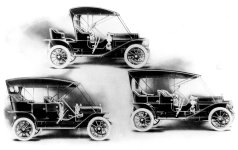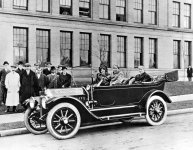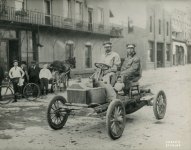teamzr1
Supporting vendor
The taproots of General Motors Their taproots reach down to carriage- and wagon-building, to firearms, stationary and marine gasoline engines, milling machinery, roller bearings, bicycle gears, lathes, and even door-bells. Their branch roots stretch back to the beginnings of scientific experiment, since the self-propelled vehicle is the child of physics and chemistry.
David Dunbar Buick, a skilled machinist, inventor and business owner in Detroit, Michigan, began producing gasoline engines around 1895. He completed two experimental automobiles before moving to Flint. Michigan and incorporating the Buick Motor Company in 1903.
Raised in Flint, Michigan, William C. "Billy" Durant was a marketing genius and known as the “king of carriage makers” for building America’s most successful horse-drawn vehicle empire beginning in 1886. Originally skeptical of automobiles, he became smitten with the Buick after the company’s investors approached him to take charge of it. He took the reins in late 1904 and by 1908 had turned it into the largest automobile producer in America.
Already engaged in the machining and manufacturing business, Henry Leland founded the Cadillac Automobile Company in honor of the city of Detroit’s founder, French explorer Antoine de la Mothe Cadillac in 1902. His focus on precision manufacturing led to Cadillac's reputation as Standard of the World.
Engineer and industrialist Charles Stewart Mott's Weston-Mott Axle Co., which already produced axles for Buick, moved to Flint at the invitation of Billy Durant in 1907, the start of relationship that culminated in Mott's leadership on GM's board of directors for 60 years.
General Motors growth began almost immediately after the company's founding. Oldsmobile followed Buick into the fold in November 1908 becoming one of 25 different companies acquired during GM's first few years. Among the notable brands added were Cadillac, Oakland (the predecessor of Pontiac), the future AC Spark Plug and three brands that would form the basis of GMC: Rapid, Reliance and Randolph.
With an unprecedented number of acquisitions in a period of just two years, GM was financially over-extended and burdened with excess production capacity when the U.S. economy and vehicle market slumped unexpectedly in 1910. Although the economy and the industry quickly recovered, GM’s bankers forced founder Billy Durant’s exit and assumed management control of the company in exchange for providing new loans to keep it afloat.
The History of Durant-Dort Factory One
Factory One tells the stories of the visionaries and innovators who helped revolutionize personal transportation around the world.
Located just north of downtown Flint, the factory dates to 1880, when it was built by the Flint Woolen Mills company as a short-lived venture into cotton textiles. In 1886, William Crapo “Billy” Durant and business partner Josiah Dallas Dort leased the facility and formed the Flint Road Cart Company – which became the Durant-Dort Carriage Factory and one of the largest carriage builders in the world.
Eventually, Durant would take control of another company – Buick Motor Co. – and leverage his Durant-Dort resources to grow the young automaker into one of the most successful car companies in the country. Durant used Buick’s success to build General Motors in 1908 and turned to his friends from Flint’s carriage industry to form Chevrolet in 1911.
The carriage market eroded with the seismic societal shift to automobiles, and the Durant-Dort Carriage Company ended production at Factory One in 1917. The building and others in the complex were converted to manufacture automobiles for the new Dort Motor Company until that business ceased operations in 1924.
In the more-than 130 years since Durant and Dort set up shop at Factory One, it housed countless other businesses and was renovated in the 1980s, before falling into disrepair.
GM purchased Factory One in 2013 and transformed it, with the goal of preserving and showcasing the original architecture.
The renovation of Factory One as a modern archive and research center brings the facility full circle, preserving the shared heritage of GM and Flint as a learning tool for future generations.
William Durant dropped out of school at age 17. Ignoring his family’s expectations for him to become a lawyer, Durant’s first job was piling lumber, and his second job was selling cigars. He alone sold more than three other sales people combined.
By age 24, Durant was already a successful businessman in the old lumber town of Flint, Michigan.
Durant, who went on to become a partner in a thriving insurance agency, decided to get into the vehicle business in 1886. He bought a small horse cart company with borrowed money. All he got was two completed carts and a design patent. Durant immediately took one cart to a fair and won a blue ribbon. He came home with orders for more than 600 carts even though he had yet to build one.
Within 15 years, the Durant-Dort Carriage Company had grown from a $2,000 investment into a $2 million business. It had become the largest vehicle manufacturer in the U.S., with Factory One its first plant in Flint. William Durant was heralded as the "King of Carriage Makers."


David Dunbar Buick, a skilled machinist, inventor and business owner in Detroit, Michigan, began producing gasoline engines around 1895. He completed two experimental automobiles before moving to Flint. Michigan and incorporating the Buick Motor Company in 1903.
Raised in Flint, Michigan, William C. "Billy" Durant was a marketing genius and known as the “king of carriage makers” for building America’s most successful horse-drawn vehicle empire beginning in 1886. Originally skeptical of automobiles, he became smitten with the Buick after the company’s investors approached him to take charge of it. He took the reins in late 1904 and by 1908 had turned it into the largest automobile producer in America.
Already engaged in the machining and manufacturing business, Henry Leland founded the Cadillac Automobile Company in honor of the city of Detroit’s founder, French explorer Antoine de la Mothe Cadillac in 1902. His focus on precision manufacturing led to Cadillac's reputation as Standard of the World.
Engineer and industrialist Charles Stewart Mott's Weston-Mott Axle Co., which already produced axles for Buick, moved to Flint at the invitation of Billy Durant in 1907, the start of relationship that culminated in Mott's leadership on GM's board of directors for 60 years.
General Motors growth began almost immediately after the company's founding. Oldsmobile followed Buick into the fold in November 1908 becoming one of 25 different companies acquired during GM's first few years. Among the notable brands added were Cadillac, Oakland (the predecessor of Pontiac), the future AC Spark Plug and three brands that would form the basis of GMC: Rapid, Reliance and Randolph.
With an unprecedented number of acquisitions in a period of just two years, GM was financially over-extended and burdened with excess production capacity when the U.S. economy and vehicle market slumped unexpectedly in 1910. Although the economy and the industry quickly recovered, GM’s bankers forced founder Billy Durant’s exit and assumed management control of the company in exchange for providing new loans to keep it afloat.
The History of Durant-Dort Factory One
Factory One tells the stories of the visionaries and innovators who helped revolutionize personal transportation around the world.
Located just north of downtown Flint, the factory dates to 1880, when it was built by the Flint Woolen Mills company as a short-lived venture into cotton textiles. In 1886, William Crapo “Billy” Durant and business partner Josiah Dallas Dort leased the facility and formed the Flint Road Cart Company – which became the Durant-Dort Carriage Factory and one of the largest carriage builders in the world.
Eventually, Durant would take control of another company – Buick Motor Co. – and leverage his Durant-Dort resources to grow the young automaker into one of the most successful car companies in the country. Durant used Buick’s success to build General Motors in 1908 and turned to his friends from Flint’s carriage industry to form Chevrolet in 1911.
The carriage market eroded with the seismic societal shift to automobiles, and the Durant-Dort Carriage Company ended production at Factory One in 1917. The building and others in the complex were converted to manufacture automobiles for the new Dort Motor Company until that business ceased operations in 1924.
In the more-than 130 years since Durant and Dort set up shop at Factory One, it housed countless other businesses and was renovated in the 1980s, before falling into disrepair.
GM purchased Factory One in 2013 and transformed it, with the goal of preserving and showcasing the original architecture.
The renovation of Factory One as a modern archive and research center brings the facility full circle, preserving the shared heritage of GM and Flint as a learning tool for future generations.
William Durant dropped out of school at age 17. Ignoring his family’s expectations for him to become a lawyer, Durant’s first job was piling lumber, and his second job was selling cigars. He alone sold more than three other sales people combined.
By age 24, Durant was already a successful businessman in the old lumber town of Flint, Michigan.
Durant, who went on to become a partner in a thriving insurance agency, decided to get into the vehicle business in 1886. He bought a small horse cart company with borrowed money. All he got was two completed carts and a design patent. Durant immediately took one cart to a fair and won a blue ribbon. He came home with orders for more than 600 carts even though he had yet to build one.
Within 15 years, the Durant-Dort Carriage Company had grown from a $2,000 investment into a $2 million business. It had become the largest vehicle manufacturer in the U.S., with Factory One its first plant in Flint. William Durant was heralded as the "King of Carriage Makers."




